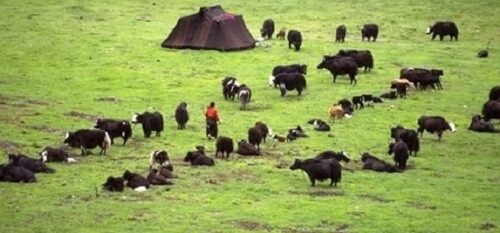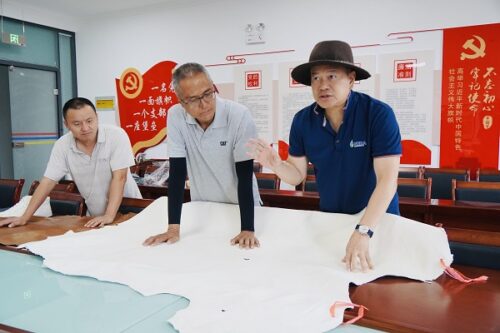17 Aug 2022
In the Tibet Autonomous Region of China, the tanning of yak hides is underway in a project led by the ChromFree Leather Alliance and the Third Pole of The Earth Leather Industrial Company Limited.

Yaks grazing on the Qinghai-Tibetan Plateau
This tannery sits naturally by the Yarlung Zangbo River, the highest river in the world. It originates from the Majieyangzom glacier in the southwest of the Tibetan Plateau and flows from west to east and then southward around Namjag Barwa, the eastern end of the Himalayas, and finally into the Indian Ocean.
The Third Pole of The Earth Leather Industrial Company Limited tans yak hides using zoology, a process that is based on the mineral zeolite and is chrome-free, heavy metal-free and aldehyde-free. Both tanned and untanned scraps or fleshings are re-used instead of going to landfill. They can, for example, be a circular source of bovine collagen, which has many high-end applications in tissue engineering, biomaterials, cosmetics, and the pharmaceutical industry.

On right Francis Tsang co-founder of the ChromeFree Leather Alliance with Nyima,(centre), chairman of The Third Pole of the Earth Leather Industrial Company Limited
The project is about more than tanned yak leather as it has important environmental and social components. For example, fewer yak hides go to landfill, minimising waste, when it was previously about 50%; the tanning activity has helped maintain the population of the villages in Tibet by offering the younger generation employment opportunities.
As the yak tanning project is located on the Qinghai-Tibetan Plateau (QTP) which is 40% alpine meadow grassland, it is ideal for grazing the yak herds that contribute to the preservation of the plateau based in the practices of regenerative farming. These practices include enhancing biodiversity, conserving water, composting, and limiting the number of animals along with environmental and soil conservation.
The project sources its raw materials locally, this reducing transport costs, and ensuring that herders maintain their animals.
Preserving the QTP is vital for other reasons as it is a source of biodiversity, upper water sheds for large rivers, forage and habitat for livestock and an important store of carbon that grazing animals help preserve.
我们为皮革、物料及时装业界创造面对面洽谈的机会,为客户缔造实质商机。我们云集世界各地的商家,让他们寻找新的合作伙伴,发掘潜在客户或供应商,并掌握业界最新发展。
我们主办多个专注时尚及生活潮流的商贸展览会, 为这不断变化的行业,提供最全面的买家及参展商服务,方便他们了解急速转变的行业环境,并预测来季趋势。

使用条款 | 隐私政策 | APLF 可持续发展